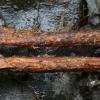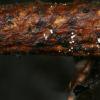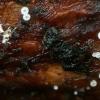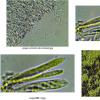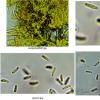
22-03-2017 23:25
 Bernard CLESSE
Bernard CLESSE
Bonsoir à tous,Quel est cet asco poussant sur pé

21-03-2017 16:24
 Francine Nouls
Francine Nouls
Substrate is not common (normally leaves, twigs)

24-05-2016 16:50
Lepista ZacariasThis specimen was collected in the sand dunes clos

21-03-2017 12:58
Madera no identificada... posiblemente pinoA ver

21-03-2017 18:46
Lepista ZacariasHi everyone,This fungus was found on pine needles
Asco sur pétiole pourri de Dryopteris filix-mas
Bernard CLESSE,
22-03-2017 23:25
 Bonsoir à tous,
Bonsoir à tous,Quel est cet asco poussant sur pétioles et rachis pourris de frondes de fougère mâle ?
a) asques IKI+
b) spores étroitement fusiformes : 6-6,5x1,5
c) excipulum deventant bleu-noir dans le lugol
Qu'en pensez-vous ?
Bernard
Christian Verpoorte,
22-03-2017 23:48
Re : Asco sur pétiole pourri de Dryopteris filix-mas
Bonsoir Bernard,
Regarde un peu du côté de Psilachnum chrysostigmum, ça ressemble bien à ça (Ascomyceti d'Italia p. 232, Champignons de Suisse 1 p. 173).
Se trouve aussi sous Pezizella chrysostigma (Ellis p. 563).
Christian
Bernard CLESSE,
23-03-2017 12:46

Re : Asco sur pétiole pourri de Dryopteris filix-mas
Grand merci pour ta réponse Christian !
Je connaissais bien Psilachnum chrysostigmum var. versicolor sur Asplenium scolopendrium mais ignorais qu'il y avait une autre sous-espèce sur d'autres fougères ! Il s'agit donc dès lors bien de Psilachnum chrysostigmum var. chrysostigmum.
Ce qui explique aussi la réaction violette ou bleu noirâtre de certaines cellules dans IKI ! Je n'ai pas la documentation sous la main mais qui peut me rappeler quelle cellule réagit ainsi : excipulum ou autre ??
Merci d'avance pour vos réponses !
Bernard
Je connaissais bien Psilachnum chrysostigmum var. versicolor sur Asplenium scolopendrium mais ignorais qu'il y avait une autre sous-espèce sur d'autres fougères ! Il s'agit donc dès lors bien de Psilachnum chrysostigmum var. chrysostigmum.
Ce qui explique aussi la réaction violette ou bleu noirâtre de certaines cellules dans IKI ! Je n'ai pas la documentation sous la main mais qui peut me rappeler quelle cellule réagit ainsi : excipulum ou autre ??
Merci d'avance pour vos réponses !
Bernard
